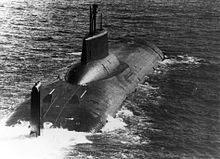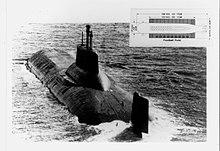Typhoon-class submarine
From Wikipedia, the free encyclopedia
(Redirected from Typhoon class submarine)

Typhoon-class SSBN profile
| |

Typhoon-class submarine underway
| |
| Class overview | |
|---|---|
| Name: | Akula (Акула) (NATO: Typhoon) |
| Builders: | Sevmash, designed by Rubin |
| Operators: | |
| Preceded by: | Delta class submarine |
| Succeeded by: | Borei class submarine |
| Built: | 1976–1986 |
| In service: | 1981–present |
| In commission: | 1981–1989 |
| Planned: | 7 |
| Completed: | 6 |
| Cancelled: | 1 |
| Active: | 1 |
| Laid up: | 2 |
| Retired: | 3 |
| General characteristics | |
| Type: | Ballistic missile submarine |
| Displacement: | |
| Length: | 175 m (574 ft 2 in) |
| Beam: | 23 m (75 ft 6 in) |
| Draught: | 12 m (39 ft 4 in) |
| Propulsion: |
|
| Speed: |
|
| Endurance: | 120+ days submerged[1] |
| Test depth: | 400 m (1,300 ft) |
| Complement: | 160[1] |
| Armament: |
|
The Russian Navy canceled its Typhoon modernization program in March 2012, stating that modernizing one Typhoon would be as expensive as building two new Borei-class submarines.[6] With the announcement that Russia has eliminated the last SS-N-20 Sturgeon SLBMs in September 2012, the remaining Typhoons have reached the end of service.[7]
Description[edit]
Besides their missile armament, the Typhoon class features six torpedo tubes; all of which are designed to handle RPK-2 (SS-N-15) missiles or Type 53 torpedoes. A Typhoon-class submarine can stay submerged for periods up to 120 days[1] in normal conditions, and potentially more if deemed necessary (e.g., in the case of a nuclear war). Their primary weapons system is composed of 20 R-39 (NATO: SS-N-20) ballistic missiles (SLBM) with a maximum of 10 MIRV nuclear warheads each. Technically, Typhoons were able to deploy their long-range nuclear missiles while moored at their docks.[8]Typhoon-class submarines feature multiple pressure hulls, similar to the World War II Japanese I-400-class submarine, that simplify internal design while making the vessel much wider than a normal submarine. In the main body of the sub, two long pressure hulls lie parallel with a third, smaller pressure hull above them (which protrudes just below the sail), and two other pressure hulls for torpedoes and steering gear. This also greatly increases their survivability—even if one pressure hull is breached, the crew members in the other are safe and there is less potential for flooding.
History[edit]
In the early 1990s, there were also intentions to rebuild some of the Typhoon-class submarines to submarine cargo vessels for shipping oil, gas and cargo under polar ice to Russia’s far flung northern territories. The submarines could take up to 10,000 tonnes of cargo on-board and ship it under the polar ice to tankers waiting in the Barents Sea. These ships — after the considerable engineering required to develop technologies to transfer oil from drilling platforms to the submarines, and later, to the waiting tankers — would then deliver their cargo world-wide.[9]
Six Typhoon-class submarines were built. Originally, the submarines were designated by hull numbers only. Names were later assigned to the four vessels retained by the Russian Navy, which were sponsored by either a city or company. The construction order for an additional vessel (hull number TK-210) was canceled and never completed. Only the first of these submarines to be constructed, the Dmitriy Donskoy, is still in active service with the Russian Navy, serving as a test platform for the Bulava (SS-NX-32) missile. The Arkhangelsk (TK-17) and Severstal (TK-20) remain in reserve, not currently active with the Russian fleet. All the R-39 missiles have been retired. The Typhoons have since been replaced by the Borei class since 2010-2011.
In late December 2008, a senior Navy official announced that the two Typhoon-class submarines, the TK-17 and TK-20, that are in reserve would not be rearmed with the new Bulava SLBM missile system. They could however be modified to carry cruise missiles or to lay mines, or could be used in special operations.[10] In late June 2009, the Navy Commander-in-Chief, Admiral Vladimir Vysotskiy told reporters that the two submarines would be reserved for possible future repairs and modernization.[11] In May 2010, the Navy Commander-in-Chief reported that Russia's Typhoon-class submarines would remain in service with the Navy until 2019.[12] In September 2011, the Russian defense ministry decided to write off all Project 941 Akula nuclear-powered ballistic missile submarines until 2014. The reasons for decommissioning the Typhoon class vessels are the restrictions imposed on Russia by the Strategic Arms Reduction Treaty and successful trials of new Borei-class submarine.[13]
Despite being a replacement for many types of submarines, the Borei class submarines are slightly smaller than the Typhoon class in terms of length (170 m as opposed to 175 m) and crew (107 people as opposed to 160). These changes were in part designed to reduce the cost to build and maintain the submarines. In addition, the United States and Canada provided 80% of funds for scrapping the older Typhoon class submarines, making it much more economical to build a new submarine.[14] However, according to other sources at the Russian defence ministry, no such decision has been made; in that case, the submarines would remain with the Russian Navy.,[15] Submarines TK-17 Arhangelsk and TK-20 Severstal will not be modernized as platforms for cruise missiles, but they will be kept in service with their previous armament, R-39 missiles.
In 2013, the State-Run RIA Novosti news has announced that the Navy will scrap two Typhoons beginning in 2018. They will be the TK-17 and TK-20.[16] As of 2017, the decision about scrapping of TK-17 and TK-20 is still not certain.[17]
Units[edit]
| # | Name | Laid down | Launched | Commissioned | Fleet | Status |
|---|---|---|---|---|---|---|
| TK-208 | Dmitriy Donskoy | 30 June 1976 | 27 September 1979 | 23 December 1981 | Northern Fleet | 20] |
| TK-202 | 22 April 1978 | 23 September 1982 | 28 December 1983 | |||
| TK-12 | Simbirsk | 19 April 1980 | 17 December 1983 | 26 December 1984 | ||
| TK-13 | 23 February 1982 | 30 April 1985 | 26 December 1985 | |||
| TK-17 | Arkhangelsk | 9 August 1983 | 12 December 1986 | 15 December 1987 | Northern Fleet | |
| TK-20 | Severstal | 27 August 1985 | 11 April 1989 | 19 December 1989 [1] | Northern Fleet | |
| TK-210 | 1986 |
Timeline[edit]
TK-208 Dmitriy Donskoy (Typhoon #1)- 10 February 1982: Entered 18th division (Zapadnaya Litsa), NOR.
- December 1982: Transferred from Severodvinsk to Zapadnaya Litsa.
- 1983-1984: Tests of D-19 missile complex. Commanders: A.V.Olkhovikov (1980–1984).
- 3 December 1986: Entered Navy Board of the Winners of the Socialist Competition.
- 18 January 1987: Entered MoD Board of Glory.
- 20 September 1989 – 1991: Repairs and refit at Sevmash to Project 941U. 1991 refit cancelled.
- 1996: Returned to 941U refit.
- 2002: Named Dmitriy Donskoy.
- 26 June 2002: End of refit.
- 30 June 2002: Start of testing.
- 26 July 2002: Entered sea trials, Re-entered fleet, without missile system.
- December 2003: Sea trials; refitted to carry a new Bulava missile system. New missile system expected to be operational by 2005.
- 9 October 2005: Successfully launched SS-NX-30 Bulava SLBM from surface.
- 21 December 2005: Successfully launched SS-NX-30 Bulava SLBM from submerged position on move.
- 7 September 2006: Test launch of the Bulava missile failed after several minutes in flight due to the problems in the flight control system. The missile fell into the sea about a minute after the launch. The sub was not affected and was returning to Severodvinsk base submerged. Later reports blamed the engine of the first stage for the failure.
- 25 October 2006: Test launch of the Bulava-M missile in the White Sea failed some 200 seconds after liftoff due to the apparent failure of the flight control system.
- 28 August 2008: Underwent successful testing at the Sevmash shipyard in Severodvinsk, Arkhangelsk Oblast. More than 170 men worked with the Dmitriy Donskoy, 100 of them employed at the Sevmash plant and 70 at other companies.
- As of 2017, the submarine is still in active service.[22]





Ingen kommentarer:
Legg inn en kommentar
Merk: Bare medlemmer av denne bloggen kan legge inn en kommentar.